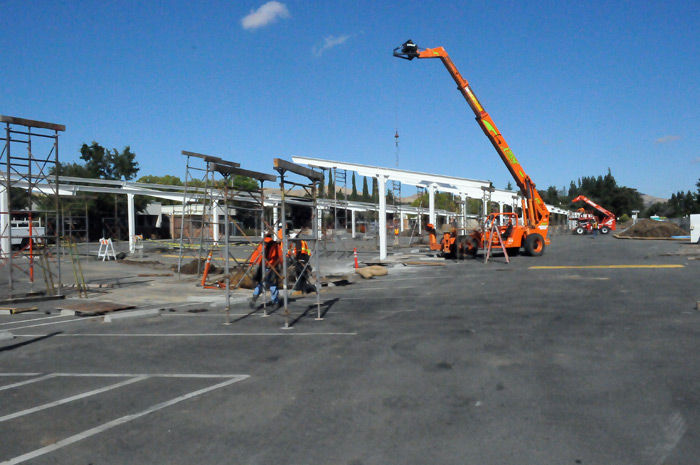Newly proposed state legislation seeks to motivate companies to turn their parking lots into functional-use large scale solar farms.
Senate Bill 49, announced during the first day of California’s new legislative session, would create a tax incentive for commercial building owners to build “solar canopies” — overhanging solar panel structures — above their large parking lots.
State Sen. Josh Becker, D-San Mateo, author of the legislation, hopes SB 49 will create more local clean energy in cities and suburbs by taking advantage of spaces capable of having solar panels above them, rather than seeking out rare and expensive plots of undeveloped land.
“That’s what makes the solar canopy concept so appealing, because it wouldn’t require any more land, it would just give parking lot owners an incentive to make dual use of their lots by essentially putting a miniature power plant above all those cars,” Becker said in a press release.
The bill would also prevent the need for large-consuming regions to outsource their clean power sources to rural areas, which not only requires installing expensive, lengthy transmission lines, but partly inhibits agricultural areas from using their land for food and livestock production.
In a nation hoping to wean itself off of its dependency on fossil fuels, cheap and quick clean energy is critical, which is why most solar farms across the nation are built on open, undeveloped spaces like deserts, croplands and grasslands and forests, according to a global inventory published in the science journal Nature.
Compared to building thousands of small solar farms in urban spaces, large rural energy farms are technically cheaper, easier to manage and ultimately more efficient to harvest a big quantity of energy from.
But following this summer’s strained energy grid scare, legislators are getting creative to find new ways to provide clean energy to Californians in any way possible. If you’re planning to install solar systems in your California home, then you might want to first check out some California solar permit requirements here.
In one experiment, the state is funding a $20 million project to test the effectiveness of solar canopies above unprotected irrigation canal systems, called “Project Nexus”. The hope is to simultaneously reduce water evaporation and generate clean energy.
Becker’s office estimates that creating solar canopies above 400 square miles of parking lots in the state could provide 26 gigawatts of power, which is enough energy to power 6.5 million homes. For context, the state estimates it needs 110 gigawatts of solar power in order to turn 100 percent carbon-neutral by 2045.
“This is one of the many tools we’re going to need to use to hit our targets of using 90% clean energy by 2035 and achieving 100% carbon neutrality by 2045,” Becker said. “In my view, this is relatively low-hanging fruit. We’ve got the land available — now the challenge is to make better use of it.”
Just last month, the French Senate passed a policy that requires all parking lots with more than 80 spaces to install solar canopies. The French government said this legislation has the potential to generate 10 nuclear reactors worth of energy.
And in March, Washington state allowed businesses to pay off their sales and use taxes from buying solar canopy equipment over an eight-year period.
An assigned Senate policy committee will review SB 49 in early 2023.



If we’re going to have solar farms, shouldn’t they be located on the sun?
I would first ask them to recalculate those estimates of 26 gigawatts, knowing how off every estimate ever made by a legislator is. Bet it would be closer to 12 GW (just a sardonic guess). I also thought those panels heated up to a point where birds flying over them got roasted. That’d be a lot of dead birds.
They tax our tax money, give it to a greedy corporation to build solar over their parking lot and power their building and save them money, making them even more greedy?
The greedy corporation in turn donates to their campaigns. It’s a never ending cycle all funded by taxpayers. I understand buying influence and a political voice. Doing it in this corrupt circle and using our tax dollars is criminal. But nobody around here is sophisticated enough to think about anything except football and kim.
I think this is actually a great idea. It’s too bad the government is going to get involved now and screw it up.
… there is an endless stream of draconian edicts from Sacramento which takes away local discretion.
.
I’m sick of it.
NANO NANO
Why should I, a tax paying citizen, be paying for or subsidizing someone else’s solar panels? Also, I see nothing in this proposal about supporting America and specifically, that the cells, panel assemblies, racks, and controllers/inverters should all be manufactured and built in the USA.
Does any body fact check anymore? ‘Becker’s office estimates that creating solar canopies above 400 square miles of parking lots in the state could provide 26 gigawatts of power..”
400 square miles of parking lots? Really? Does the author know the entire city of Los Angeles is about 460 square miles? 400 square miles would be almost the size of 10 San Francisco’s.
@Always Right – Your comment prompted me to take a look at how large an array we would need to have a 26 gigawatt capacity. Here’s a table of some existing arrays, their area in square miles, their capacity in gigawatts, and the last column is the square miles we would need for a capacity of 26 gigawatts. It looks like we could do it with a 250 square mile system though obviously it would need to be in the desert and not over parking lots.